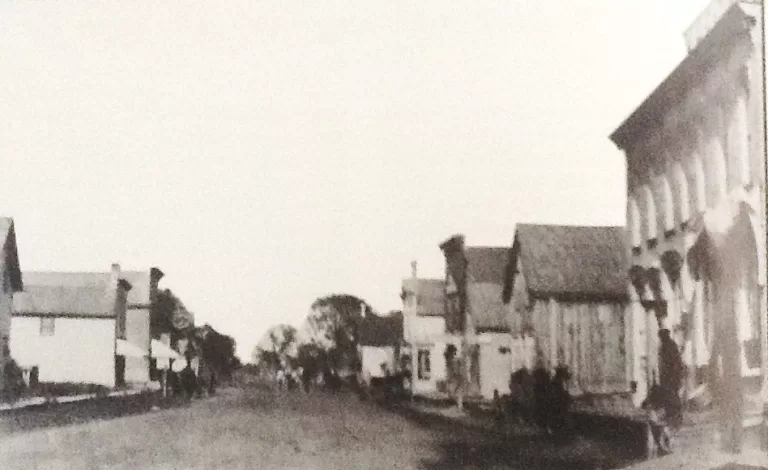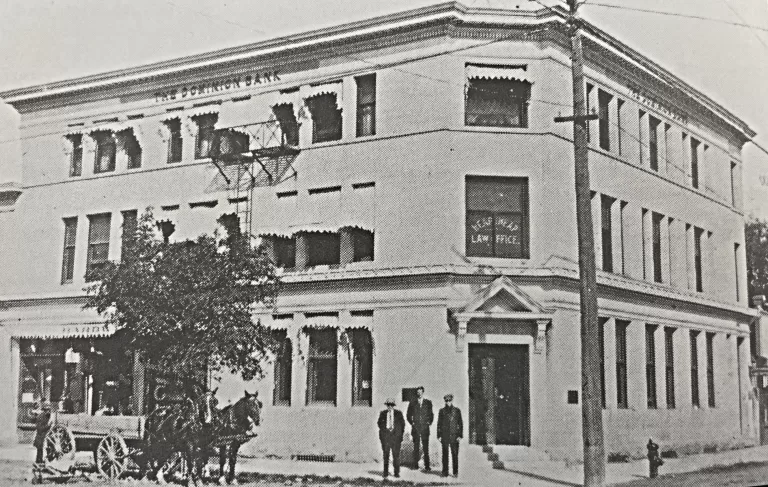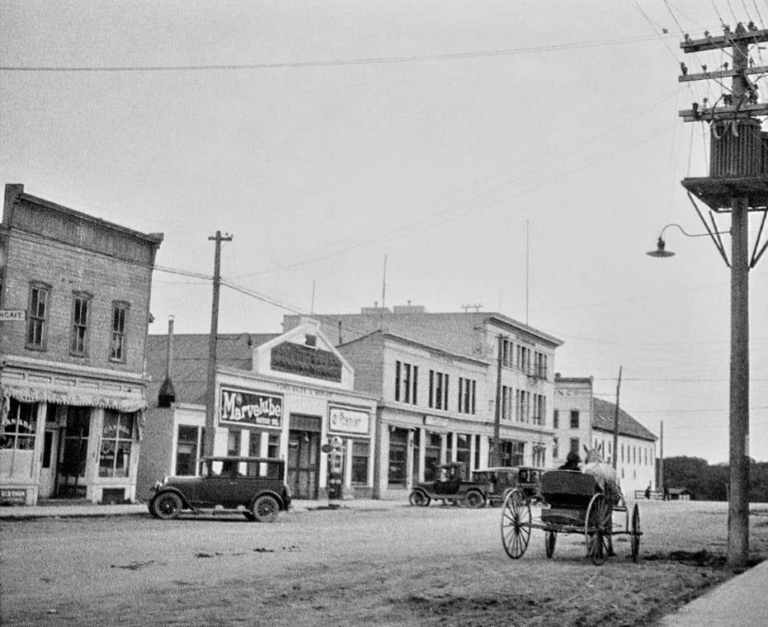Manitoba was Canada’s fifth province and its first expansion into the west.
Selkirk was one of the first new towns in this new province. With the prospects of becoming the transportation hub for western Canada, Selkirk was a town with unlimited potential.
A street named “Manitoba” captured the feelings of enthusiasm and optimism about the new province.
Slow Beginnings
By 1885, Eveline was Selkirk’s main business street because it was closest to the waterfront where all the major industries such as shipping, fish and timber processing were located.
Businesses that might not be successful or were unable to afford the rents on Eveline located on Manitoba.
The avenue was wide and muddy with wooden sidewalks, or just planks across the mud holes.
The boom town store fronts give the impression of grandeur. The building’s front walls extend two-stories, creating an optimistic feeling. However, upon entering, a customer finds a low one-storey store.
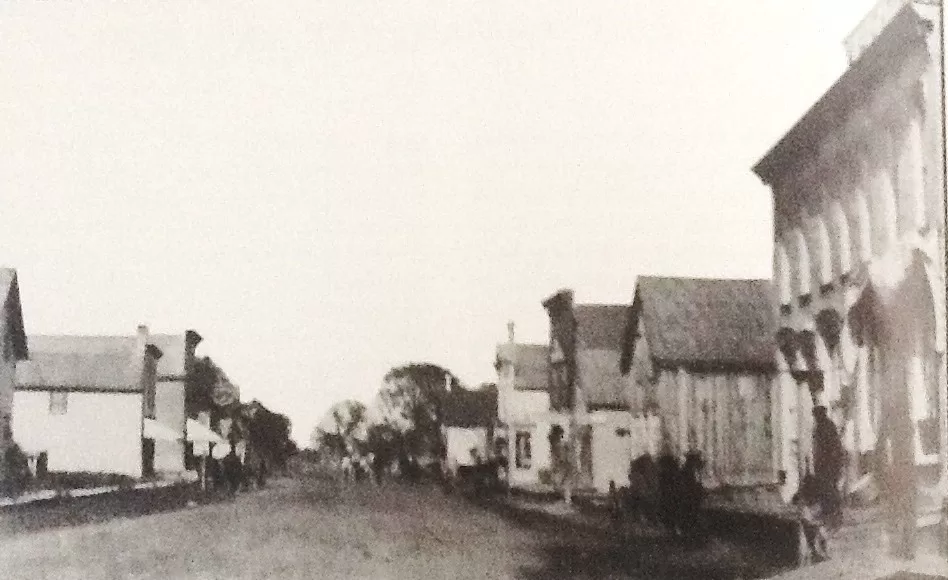
Selkirk’s “Boom”
By 1900, the massive St. Andrews Marsh – the “Big Bog” between McPhillips Road and Stonewall had been drained. This opened thousands of acres of new farmland. New farmers settled in the freshly drained lowlands. Farming villages like Clandeboye, Petersfield, Ercildoune, Hartley, Dunora, and Greenwood sprang up north and west of Selkirk.
Stores with goods suited to the needs of farmers opened on Manitoba Avenue. The livery stables, dairies and corrals soon gave way to shops, hardware stores, and doctors and lawyers offices. The town’s economy expanded by serving the new communities.
Two fine brick buildings, the new Merchants Hotel and the Traders/Dominion Bank, opened in 1904 at Manitoba and Eveline. Like pillars in a gateway these sturdy twin “towers” announced that opportunity was to be found in the west!
When the Post Office building opened at Manitoba and Main in 1909, it confirmed that even the federal government regarded Selkirk as an important regional centre. From that point onward, future growth in the town would be along Manitoba and along the trail known as Main Street. For the first time, Selkirk turned away from the waterfront economy which had sustained the town from its beginnings.
For 80 years, Manitoba Avenue was Selkirk’s main commercial street. The picturesque “Boom town” fronts, the shops, hotels and eateries provided all of the services of the big city, but with a friendliness that Selkirk …and its customers valued.
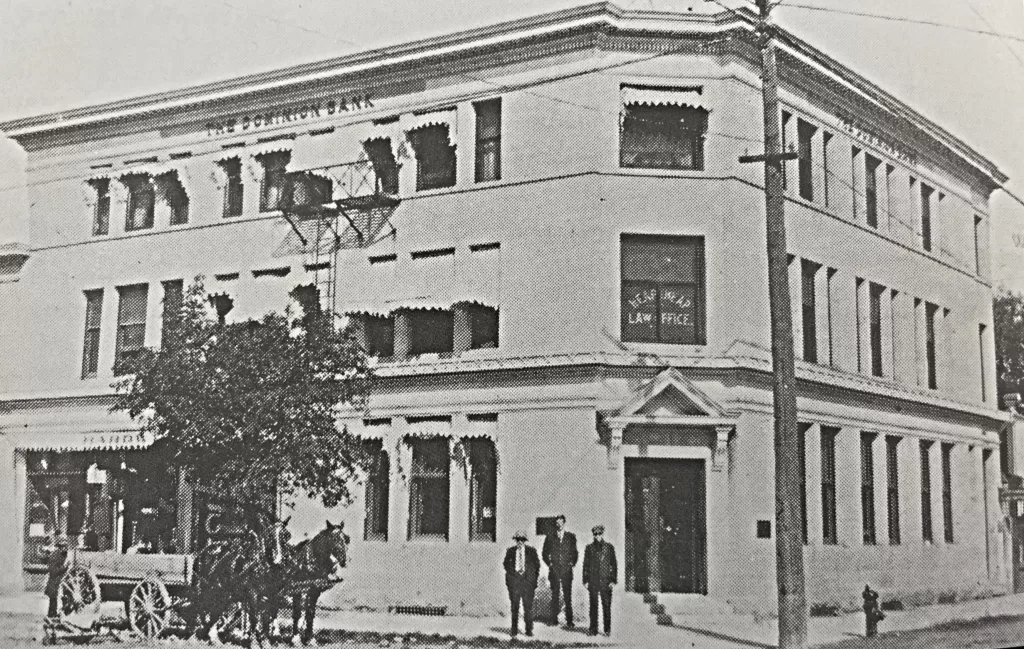
Moon Shines Over Manitoba
Selkirk’s tolerance of booze was legendary! Solace for the hardships of pioneer life was often found in a “moonshine” bottle or in a glass of beer at the local hotel! From Selkirk’s founding, inns, and temporary “booze pigs” sprang up on the waterfront to offer beverages to railway, timber and ship workers.
One of the earliest dry goods merchants made his fortune selling illegal whiskey out the backdoor. His store on Eveline was around the corner from the magistrate’s house, the town hall and the Masonic lodge, but no one complained. Though the town voted to prohibit alcohol sales in the mid-1880’s, unofficial sales continued.
The Merchants Hotel, the Lisgar House Hotel and others offered booze and “accommodations” to travelers from the late 1870’s on. Even into the 1960’s, as many as 30 drunken men could be seen brawling near the corner of Manitoba and Eveline on a Friday night.
Avenue Stories
The town constable was beside himself with the number of drunks he had to fight, wrestle and put into the cells on Eaton Avenue. In 1908, the unsympathetic town council voted to assist him in his task by giving him a “paddy wagon” – a device with one wheel at the front and two handles at the rear- a wheelbarrow!
One day, Alec, the Barber, was standing outside his shop said to the lawyer, whose office was next door, “Beautiful day, isn’t it?
The lawyer, who was known as a joker, replied: “It certainly is” and then sent the barber a bill for $5.00 for “the consultation”. A few days later, the barber met the lawyer again and said “Beautiful Day!” And after a pause: “I’m not askin’, I’m tellin”.
In 1896, in one Manitoba Avenue hotel stable, a late-night arriver left a lantern lit and then went to find some supper. While he was away, the lantern somehow overturned. A fire began that eventually destroyed more than 20 buildings on the block between Manitoba and Clandeboye. It cost one store owner his life.
Until 1904, Selkirk had no fire brigade and no pressurized water system or hydrants. Neighbours could only throw buckets of water to stop a house fire. Big fires were a constant threat to a town with so many wooden buildings. Fires destroyed parts of downtown Selkirk in 1894, 1896, 1904 and 1906.
Sources
Selkirk the First Hundred Years, Barry Potyondi


